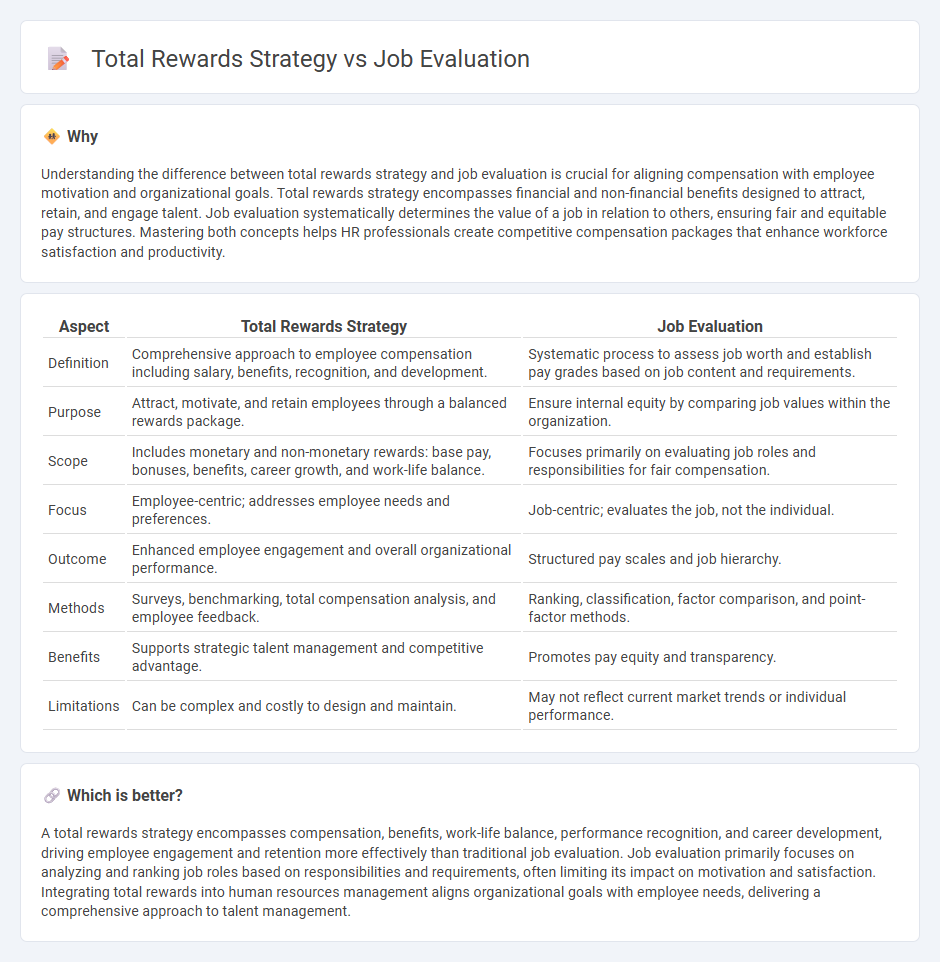
Total rewards strategy focuses on maximizing employee value through competitive compensation, benefits, and recognition programs aligned with organizational goals. Job evaluation systematically assesses job roles to establish equitable pay structures based on responsibilities, skills, and market data. Explore the distinctions between these approaches to optimize your HR practices effectively.
Why it is important
Understanding the difference between total rewards strategy and job evaluation is crucial for aligning compensation with employee motivation and organizational goals. Total rewards strategy encompasses financial and non-financial benefits designed to attract, retain, and engage talent. Job evaluation systematically determines the value of a job in relation to others, ensuring fair and equitable pay structures. Mastering both concepts helps HR professionals create competitive compensation packages that enhance workforce satisfaction and productivity.
Comparison Table
| Aspect | Total Rewards Strategy | Job Evaluation |
|---|---|---|
| Definition | Comprehensive approach to employee compensation including salary, benefits, recognition, and development. | Systematic process to assess job worth and establish pay grades based on job content and requirements. |
| Purpose | Attract, motivate, and retain employees through a balanced rewards package. | Ensure internal equity by comparing job values within the organization. |
| Scope | Includes monetary and non-monetary rewards: base pay, bonuses, benefits, career growth, and work-life balance. | Focuses primarily on evaluating job roles and responsibilities for fair compensation. |
| Focus | Employee-centric; addresses employee needs and preferences. | Job-centric; evaluates the job, not the individual. |
| Outcome | Enhanced employee engagement and overall organizational performance. | Structured pay scales and job hierarchy. |
| Methods | Surveys, benchmarking, total compensation analysis, and employee feedback. | Ranking, classification, factor comparison, and point-factor methods. |
| Benefits | Supports strategic talent management and competitive advantage. | Promotes pay equity and transparency. |
| Limitations | Can be complex and costly to design and maintain. | May not reflect current market trends or individual performance. |
Which is better?
A total rewards strategy encompasses compensation, benefits, work-life balance, performance recognition, and career development, driving employee engagement and retention more effectively than traditional job evaluation. Job evaluation primarily focuses on analyzing and ranking job roles based on responsibilities and requirements, often limiting its impact on motivation and satisfaction. Integrating total rewards into human resources management aligns organizational goals with employee needs, delivering a comprehensive approach to talent management.
Connection
Total rewards strategy integrates compensation, benefits, and recognition frameworks directly influenced by job evaluation outcomes that assess role value and complexity. Job evaluation establishes a systematic basis for ranking positions, ensuring equitable pay structures aligned with organizational goals and market benchmarks. Aligning total rewards with job evaluation enhances employee motivation, retention, and overall workforce productivity.
Key Terms
**Job Evaluation:**
Job evaluation systematically assesses the relative value of jobs within an organization to ensure fair and equitable compensation structures. It involves techniques such as point-factor, ranking, or classification methods to establish job worth based on factors like skills, responsibilities, and working conditions. Explore more about how job evaluation supports effective total rewards strategies and drives organizational equity.
Job Analysis
Job analysis provides the foundation for job evaluation by systematically identifying job responsibilities, skills, and requirements, which ensures accurate and fair compensation structures in a total rewards strategy. Effective job evaluation methods, such as point-factor or ranking systems, leverage job analysis data to align pay scales with organizational goals and market competitiveness. Explore how integrating detailed job analysis enhances your total rewards strategy for optimized employee satisfaction and retention.
Pay Structure
Job evaluation systematically determines the relative worth of positions within an organization, forming the foundation for equitable pay structures. Total rewards strategy integrates compensation, benefits, and recognition to attract and retain talent while aligning with business goals. Explore how aligning job evaluation with total rewards strategy optimizes pay structure effectiveness.
Source and External Links
Job Evaluation: Your 2025 Guide - This guide provides an overview of job evaluation methods, including qualitative and quantitative approaches, to determine the relative value of different jobs.
What Is a Job Evaluation? - Job evaluations help determine equitable pay by comparing job responsibilities, ensuring fair compensation for the value each position brings to the organization.
Job Evaluation Guide - This guide outlines the process of evaluating jobs based on duties, responsibilities, and specifications, to classify positions correctly regarding title, salary, and overtime exemption.
 dowidth.com
dowidth.com